英语演讲选修教案16
大学生英语演讲课教案
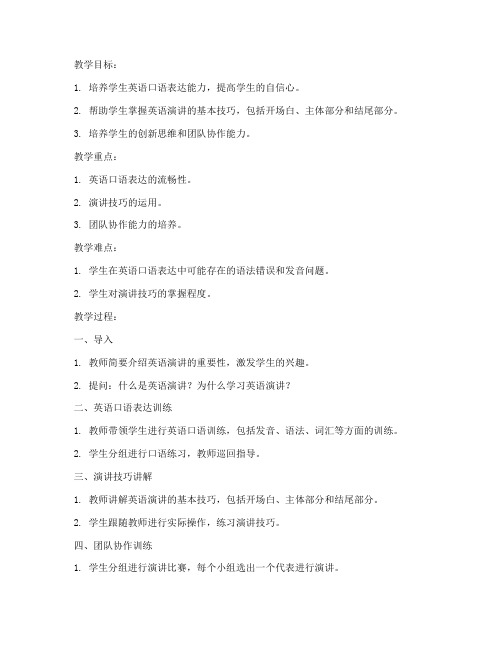
教学目标:1. 培养学生英语口语表达能力,提高学生的自信心。
2. 帮助学生掌握英语演讲的基本技巧,包括开场白、主体部分和结尾部分。
3. 培养学生的创新思维和团队协作能力。
教学重点:1. 英语口语表达的流畅性。
2. 演讲技巧的运用。
3. 团队协作能力的培养。
教学难点:1. 学生在英语口语表达中可能存在的语法错误和发音问题。
2. 学生对演讲技巧的掌握程度。
教学过程:一、导入1. 教师简要介绍英语演讲的重要性,激发学生的兴趣。
2. 提问:什么是英语演讲?为什么学习英语演讲?二、英语口语表达训练1. 教师带领学生进行英语口语训练,包括发音、语法、词汇等方面的训练。
2. 学生分组进行口语练习,教师巡回指导。
三、演讲技巧讲解1. 教师讲解英语演讲的基本技巧,包括开场白、主体部分和结尾部分。
2. 学生跟随教师进行实际操作,练习演讲技巧。
四、团队协作训练1. 学生分组进行演讲比赛,每个小组选出一个代表进行演讲。
2. 教师组织学生进行评价和讨论,培养学生的团队协作能力。
五、课堂小结1. 教师总结本节课的学习内容,强调重点和难点。
2. 学生分享学习心得,提出疑问。
六、课后作业1. 学生准备一篇英语演讲稿,内容自选。
2. 学生在家练习英语口语表达,提高发音和语法水平。
教学评价:1. 课堂参与度:观察学生在课堂上的发言次数和积极性。
2. 口语表达能力:评价学生在课堂上的口语表达流畅程度和准确性。
3. 演讲技巧运用:评价学生在演讲比赛中的技巧运用情况。
4. 团队协作能力:评价学生在小组活动中的合作精神和团队意识。
教学反思:1. 教师在课堂上要注意观察学生的反应,及时调整教学策略。
2. 注重培养学生的自信心,鼓励学生积极参与课堂活动。
3. 加强对学生的个别辅导,关注学生的发音和语法问题。
4. 课后及时批改学生的作业,了解学生的学习情况。
北师大版高中英语选修6Unit16_Communication_Workshop_公开课教学设计
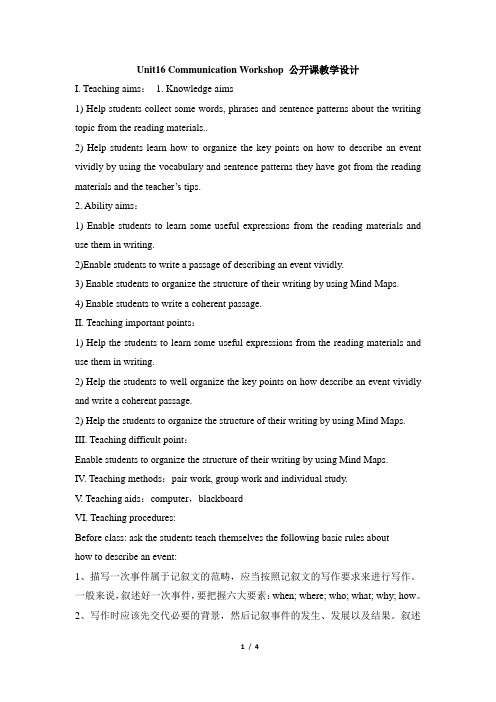
Unit16 Communication Workshop 公开课教学设计I. Teaching aims:1. Knowledge aims1) Help students collect some words, phrases and sentence patterns about the writing topic from the reading materials..2) Help students learn how to organize the key points on how to describe an event vividly by using the vocabulary and sentence patterns they have got from the reading materials and the teacher’s tips.2. Ability aims:1) Enable students to learn some useful expressions from the reading materials and use them in writing.2)Enable students to write a passage of describing an event vividly.3) Enable students to organize the structure of their writing by using Mind Maps.4) Enable students to write a coherent passage.II. Teaching important points:1) Help the students to learn some useful expressions from the reading materials and use them in writing.2) Help the students to well organize the key points on how describe an event vividly and write a coherent passage.2) Help the students to organize the structure of their writing by using Mind Maps. III. Teaching difficult point:Enable students to organize the structure of their writing by using Mind Maps.IV. Teaching methods:pair work, group work and individual study.V. Teaching aids:computer,blackboardVI. Teaching procedures:Before class: ask the students teach themselves the following basic rules abouthow to describe an event:1、描写一次事件属于记叙文的范畴,应当按照记叙文的写作要求来进行写作。
英语演讲课程教案

英语演讲课程教案英语演讲课程教案「篇一」教材分析本模块通过Simon一家为Daming 准备过生日这一情景,讲述正在发生的动作及如何向他人寻求帮助并根据客观情况说明自己能否向他人提供帮助。
谈论的话题是“大明”的生日,通过大明的生日对话来学习“我正在做什么?”“他正在做什么?”使学生掌握现在进行时, 去解释世间万物正在进行的动作变化,以及该如何向别人请求帮助。
通过使用多媒体课件及创设真实情景的方法,进行有效地操练句型,达到培养语言综合能力的目的。
学情分析根据本年级小学生的心理,生理特点,认知规律以及发展需求,根据教材的编写思想及新课程标准的理念,教师应发挥积极的引导作用。
在课堂中我以学生为主题,以人为本,设计一系列的操练活动,游戏、表演等方式来强化所学的句型和单词,充分利用多媒体教学设备创设情景,鼓励学生大胆用英语进行交流,培养学生直接用英语理解、表达和思维的能力。
教学目标(1)能力目标:能运用“Who can help me?”向他人求助;能口头运用I’m making Daming’s birthday card.说明自己正在做某事因此不能做另外的事。
(2)知识目标:a.能听、说、认、读本课词组be careful,fly away,look at。
熟练掌握重点单词careful,card,balloon,fly away以及-ing结尾的单词。
b. 掌握句子:Who can help me? I can. Sorry, I can’t. I am making Daming’s birthday card。
c.听懂会说句型:主语+谓语+-ing.I canI can`t并能在具体语境中灵活运用。
(3)情感,策略,文化等目标:通过本课学习,使学生有兴趣听英语,说英语,背歌谣,主动与他人交流。
教学重点和难点(1)难点:掌握以—ing结尾的单词,能运用“Who can help me?”向他人求助;能口头运用I’m making Daming’s birthday card.说明自己正在做某事因此不能做另外的事。
英语演讲课程教案

英语演讲课程教案一、课程简介二、教学目标1. 提高学生的英语口语表达能力。
2. 培养学生的演讲技巧和自信心。
3. 帮助学生掌握演讲的基本结构和技巧。
4. 提高学生的公众演讲能力。
三、教学内容1. 演讲的基本概念和重要性。
2. 演讲的准备和计划。
3. 演讲的开头和结尾。
4. 演讲中的语言表达和肢体语言。
5. 演讲的练习和反馈。
四、教学方法1. 讲授法:讲解演讲的基本概念、技巧和注意事项。
2. 实践法:学生进行演讲练习,教师进行指导和反馈。
3. 小组讨论法:学生分组讨论演讲相关话题,分享经验和意见。
4. 观摩法:观看优秀演讲视频,学习借鉴先进的演讲技巧。
五、教学评价1. 平时练习:对学生平时的演讲练习进行评价,关注口语表达能力、演讲技巧和自信心等方面。
2. 课堂表现:评价学生在课堂上的参与程度、合作能力和进步情况。
3. 演讲比赛:组织学生参加演讲比赛,评价演讲内容、语言表达和现场表现等方面。
4. 学生互评:鼓励学生互相评价,共同提高演讲能力。
六、教学准备1. 教材:选用适合英语演讲的课程教材,如《英语演讲艺术》等。
2. 辅助材料:提供相关的演讲范文、优秀演讲视频等资源。
3. 投影仪、音响等教学设备:用于展示PPT和播放视频材料。
4. 讲台和座位:布置合适的演讲场地。
七、教学安排1. 课时:本课程共安排16课时,每课时45分钟。
2. 课程进度:按照教学内容进行有序教学,确保每个话题都有足够的练习时间。
3. 课堂活动:结合教学内容,安排不同的课堂活动,如演讲练习、讨论等。
八、教学反思2. 关注学生的学习反馈,及时调整教学内容和难度,满足学生的学习需求。
3. 关注学生的个体差异,给予不同的学生个性化的指导和支持。
九、教学拓展1. 组织学生参加校内外英语演讲比赛,提高学生的实战能力。
2. 邀请专业英语演讲教练进行讲座或辅导,拓宽学生的视野。
3. 引导学生参加英语角等活动,增加学生的英语实践机会。
3. 对学生提出建议和期望,鼓励他们在未来的学习和生活中运用所学,不断提高自己的英语演讲能力。
英语演讲选修课教案informativespeech I
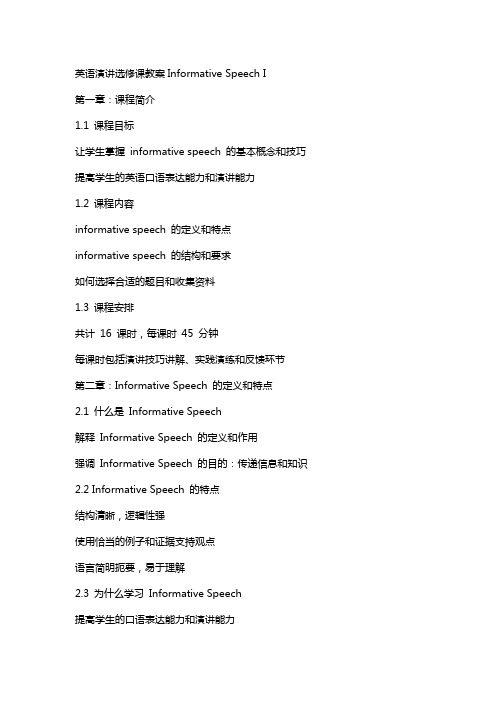
英语演讲选修课教案Informative Speech I第一章:课程简介1.1 课程目标让学生掌握informative speech 的基本概念和技巧提高学生的英语口语表达能力和演讲能力1.2 课程内容informative speech 的定义和特点informative speech 的结构和要求如何选择合适的题目和收集资料1.3 课程安排共计16 课时,每课时45 分钟每课时包括演讲技巧讲解、实践演练和反馈环节第二章:Informative Speech 的定义和特点2.1 什么是Informative Speech解释Informative Speech 的定义和作用强调Informative Speech 的目的:传递信息和知识2.2 Informative Speech 的特点结构清晰,逻辑性强使用恰当的例子和证据支持观点语言简明扼要,易于理解2.3 为什么学习Informative Speech提高学生的口语表达能力和演讲能力培养学生的研究和批判性思维能力增强学生的自信心和公众演讲技巧第三章:Informative Speech 的结构和要求3.1 结构概述引言:吸引听众的注意力,提出主题阐述主题,提供相关信息和支持论据结尾:总结全文,强调重点,提出建议或号召3.2 引言部分开头句:吸引听众的注意力,与主题相关背景信息:介绍话题的背景和重要性主题句:明确提出要传递的信息或知识3.3 部分段落结构:每段只包含一个主要观点论据支持:使用事实、数据、例子等支持观点过渡句:连接各个段落,保持演讲的连贯性3.4 结尾部分总结全文:回顾主要观点和论据强调重点:突出重要信息和观点提出建议或号召:引导听众采取行动或思考问题第四章:如何选择合适的题目和收集资料4.1 选择题目的原则个人兴趣和热情:选择自己感兴趣的话题知识储备:选择自己熟悉或有所了解的话题听众需求:考虑听众的兴趣和需求4.2 收集资料的方法图书馆研究:查阅相关书籍、杂志和期刊网络搜索:利用互联网资源进行资料收集采访专家:请教专业人士的意见和见解4.3 资料整理和筛选整理收集到的资料,分类别和关键词评估资料的可信度和可靠性筛选出与演讲主题相关的重要资料第五章:演讲技巧讲解与实践5.1 演讲技巧讲解声音与语调:保持声音的清晰和语调的抑扬顿挫肢体语言:运用合适的肢体动作表达观点和情感时间控制:掌握演讲的时间,避免超时或拖延5.2 实践演练分组练习:学生分组进行演讲练习,互相观摩和反馈角色扮演:模拟演讲场景,进行角色扮演和演讲练习录音反馈:学生录制自己的演讲,回放听取并进行自我评价5.3 反馈环节学生互相评价:给予同学演讲的反馈和建议教师评价:教师对学生的演讲进行评价和指导改进和提升:根据反馈意见进行改进,提升演讲技巧第六章:演讲的开头和结尾技巧6.1 开头技巧钩子:用一个有趣的故事、引用或问题吸引听众的注意力相关性:解释演讲与听众的关联,激发听众的兴趣定义:简洁明了地定义演讲主题,为后续内容做铺垫6.2 结尾技巧总结:回顾演讲的主要观点,强化听众的记忆呼吁行动:鼓励听众采取具体行动或思考问题留下悬念:提出一个引发思考的问题,为后续讨论提供话题第七章:使用视觉辅助材料7.1 视觉辅助材料的作用增强演讲的吸引力:通过图片、图表等视觉元素吸引听众的注意力辅助说明:用视觉材料展示数据、流程或概念,使内容更清晰易懂提高记忆:视觉元素有助于听众更好地记忆和理解演讲内容7.2 选择合适的视觉辅助材料图片:选用与演讲主题相关的图片,简洁明了地表达观点图表:用图表展示数据和趋势,使信息更直观易懂幻灯片:制作简洁清晰的幻灯片,辅助说明演讲内容7.3 使用视觉辅助材料的注意事项视觉元素与演讲内容紧密结合,避免无关或过多的装饰确保视觉辅助材料清晰可见,避免文字过小或颜色过于刺眼适时展示视觉辅助材料,与演讲内容同步,避免中断演讲流程第八章:处理紧张和失误8.1 认识紧张和失误紧张:面对听众时的自然情绪反应,影响演讲的表现失误:演讲过程中出现的口误、忘词等情况8.2 应对紧张的策略深呼吸:通过深呼吸放松身体和心情积极心态:调整心态,相信自己的准备和能力模拟练习:提前进行模拟练习,增加对演讲场景的熟悉度8.3 应对失误的策略镇定处理:保持镇定,不要慌张,继续演讲巧妙转移:用幽默或灵活的语言转移听众注意力补救措施:如果忘词,可以简要回顾上文内容,或借助视觉辅助材料提示第九章:演讲的语音语调与表达9.1 语音语调的重要性语音:清晰准确地发音,增强语言的感染力语调:适当的抑扬顿挫,使演讲更具表现力9.2 练习发音和语调模仿训练:模仿优秀演讲者的发音和语调,提高自己的表达能力录音反馈:录下自己的演讲,回放听评,改进发音和语调注重语流:保持语言的连贯性,避免生硬或过度的停顿9.3 增强表达力使用修辞手法:运用比喻、排比等修辞手法,丰富语言表达适当运用感叹词和语气词:增强语言的情感色彩关注听众反应:根据听众的反应调整语气和表达方式第十章:演讲的评估与自我提升10.1 评估标准内容:是否完整、准确地传达了信息结构:演讲是否条理清晰、逻辑严密表达:语音语调、肢体语言是否恰当,富有感染力互动:与听众的眼神交流、提问等互动是否自然顺畅10.2 自我提升策略反思总结:每次演讲后,进行自我反思和总结,找出不足之处持续练习:定期进行演讲练习,不断提高自己的表达能力学习借鉴:观看优秀演讲者的演讲视频,学习他们的经验和技巧10.3 寻求反馈和建议向同学、老师或其他听众寻求反馈,了解自己的演讲表现根据反馈意见进行改进,提升自己的演讲能力重点和难点解析1. Informative Speech 的结构和要求:理解并掌握informative speech 的基本结构,包括引言、和结尾,以及每个部分的功能和写作要求。
中学生英语演讲教案
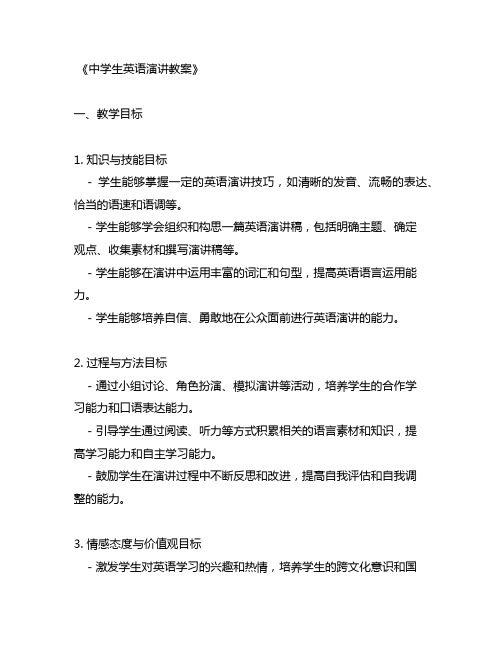
《中学生英语演讲教案》一、教学目标1. 知识与技能目标- 学生能够掌握一定的英语演讲技巧,如清晰的发音、流畅的表达、恰当的语速和语调等。
- 学生能够学会组织和构思一篇英语演讲稿,包括明确主题、确定观点、收集素材和撰写演讲稿等。
- 学生能够在演讲中运用丰富的词汇和句型,提高英语语言运用能力。
- 学生能够培养自信、勇敢地在公众面前进行英语演讲的能力。
2. 过程与方法目标- 通过小组讨论、角色扮演、模拟演讲等活动,培养学生的合作学习能力和口语表达能力。
- 引导学生通过阅读、听力等方式积累相关的语言素材和知识,提高学习能力和自主学习能力。
- 鼓励学生在演讲过程中不断反思和改进,提高自我评估和自我调整的能力。
3. 情感态度与价值观目标- 激发学生对英语学习的兴趣和热情,培养学生的跨文化意识和国际视野。
- 增强学生的自信心和自尊心,培养学生勇于表达自己观点和想法的精神。
- 通过演讲活动,培养学生的团队合作意识和竞争意识。
二、教学重难点1. 教学重点- 英语演讲技巧的训练,如发音、表达、语速语调等。
- 演讲稿的撰写和组织,包括主题的确定、观点的阐述、素材的收集等。
- 学生在演讲中的自信和流利表达能力的培养。
2. 教学难点- 如何引导学生克服紧张情绪,在公众面前自信地进行演讲。
- 如何提高学生的英语语言表达能力,使演讲稿更加生动、有趣、富有感染力。
- 如何培养学生的批判性思维和创新能力,使演讲内容具有独特性和深度。
三、教学方法1. 讲授法- 讲解英语演讲的基本知识和技巧,如发音、表达、语速语调等。
- 分析优秀英语演讲稿的特点和写作方法,为学生提供范例和指导。
2. 演示法- 教师进行示范演讲,展示正确的发音、表达和演讲技巧,让学生直观感受。
- 播放优秀的英语演讲视瓶,让学生学习借鉴他人的优点。
3. 练习法- 组织学生进行小组讨论、角色扮演、模拟演讲等活动,让学生在实践中提高演讲能力。
- 布置演讲稿撰写和演讲练习任务,让学生通过反复练习巩固所学知识和技能。
英语演讲训练及赏析分课时教案
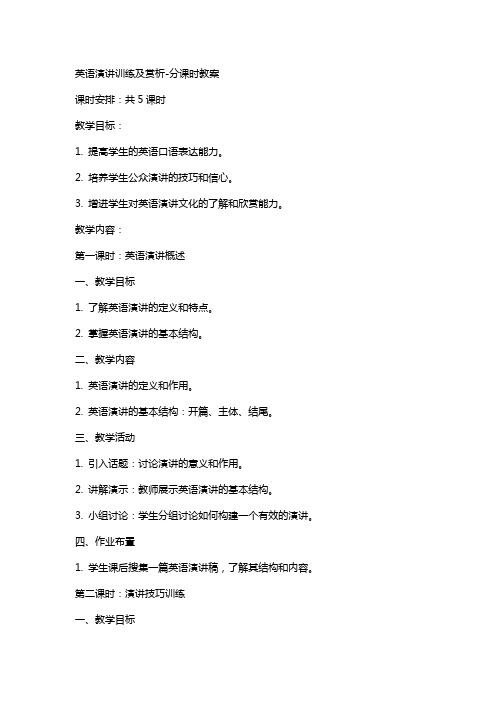
英语演讲训练及赏析-分课时教案课时安排:共5课时教学目标:1. 提高学生的英语口语表达能力。
2. 培养学生公众演讲的技巧和信心。
3. 增进学生对英语演讲文化的了解和欣赏能力。
教学内容:第一课时:英语演讲概述一、教学目标1. 了解英语演讲的定义和特点。
2. 掌握英语演讲的基本结构。
二、教学内容1. 英语演讲的定义和作用。
2. 英语演讲的基本结构:开篇、主体、结尾。
三、教学活动1. 引入话题:讨论演讲的意义和作用。
2. 讲解演示:教师展示英语演讲的基本结构。
3. 小组讨论:学生分组讨论如何构建一个有效的演讲。
四、作业布置1. 学生课后搜集一篇英语演讲稿,了解其结构和内容。
第二课时:演讲技巧训练一、教学目标1. 学习并掌握英语演讲的技巧。
2. 提高学生的口头表达能力。
二、教学内容1. 声音控制:语速、语调、音量。
2. 肢体语言:手势、面部表情、眼神交流。
三、教学活动1. 声音控制练习:学生朗读课文,教师指导发音和语调。
2. 肢体语言练习:学生进行角色扮演,教师指导手势和表情。
四、作业布置1. 学生课后练习演讲技巧,录制视频,自我评估。
一、教学目标二、教学内容1. 演讲稿的结构:开篇、主体、结尾。
2. 写作技巧:如何吸引听众、陈述观点、总结要点。
三、教学活动1. 讲解演示:教师展示优秀演讲稿的写作技巧。
四、作业布置第四课时:演讲实践与评价一、教学目标1. 提高学生的演讲技巧和信心。
2. 培养学生的评价和反馈能力。
二、教学内容1. 学生进行演讲实践。
2. 学生互相评价和反馈。
三、教学活动1. 学生依次进行演讲,其他学生做笔记。
2. 学生互相评价,教师总结评价。
四、作业布置1. 学生根据评价反馈改进自己的演讲技巧。
第五课时:演讲赏析一、教学目标1. 增进学生对英语演讲文化的了解。
2. 提高学生的演讲欣赏能力。
二、教学内容1. 观看英语演讲视频。
2. 分析演讲者的技巧和风格。
三、教学活动1. 观看优秀英语演讲视频。
【公开课教案】北师版英语选修六 Unit 16 Stories Communication Workshop
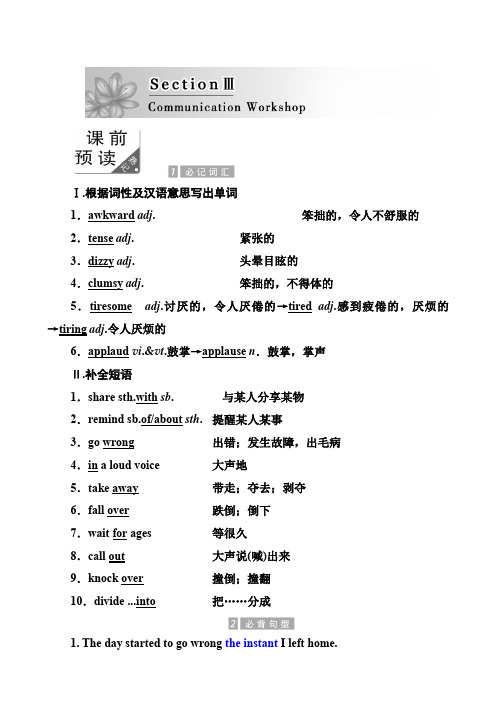
Ⅰ.根据词性及汉语意思写出单词1.awkward adj. 笨拙的,令人不舒服的2.tense adj. 紧张的3.dizzy adj. 头晕目眩的4.clumsy adj. 笨拙的,不得体的5.tiresome adj.讨厌的,令人厌倦的→tired adj.感到疲倦的,厌烦的→tiring adj.令人厌烦的6.applaud v i.&v t.鼓掌→applause n.鼓掌,掌声Ⅱ.补全短语1.share sth.with sb.与某人分享某物2.remind sb.of/about sth. 提醒某人某事3.go wrong 出错;发生故障,出毛病4.in a loud voice 大声地5.take away 带走;夺去;剥夺6.fall over 跌倒;倒下7.wait for ages 等很久8.call out 大声说(喊)出来9.knock over 撞倒;撞翻10.divide ...into 把……分成1. The day started to go wrong the instant I left home.那一天我一离开家,就开始出乱子了。
[句式分析]the instant在句中引导时间状语从句,表示“一……就……”。
[佳句赏析]一有消息我就告诉你。
The instant there is news about it, I'll let you know.2. The more I looked down, the redder my face became.我越往下看,我的脸就变得越红。
[句式分析]“the+比较级..., the+比较级...”表示“越……,越……”,后面的句子为主句。
[佳句赏析](2017·全国卷Ⅰ写作佳句)学习汉语,你说得越多,取得的进步就越大。
The more you speak in learning Chinese,the more progress you will make.3.The sun was already boiling hot and you can imagine how I felt by the time I arrived at school.太阳已经非常灼热,你可以想象我到达学校时的感觉。
英语演讲选修课教案informativespeech I

英语演讲选修课教案Informative Speech I第一章:课程介绍1.1 课程目标让学生掌握informative speech 的基本概念和技巧提高学生的英语口语表达能力和公共演讲能力培养学生的自信心和领导力1.2 课程内容介绍informative speech 的定义和特点介绍informative speech 的结构和组织方式介绍如何选择和研究informative speech 的主题介绍如何进行资料搜集和资料整理1.3 教学方法讲授与实践相结合小组讨论和同伴评价角色扮演和模拟演讲第二章:Informative Speech 的定义和特点2.1 informative speech 的定义解释informative speech 的概念和意义强调informative speech 的目的和作用2.2 informative speech 的特点介绍informative speech 的主要特点,如信息性、逻辑性和条理性等分析informative speech 与其他类型的演讲(如persuasive speech 和impromptu speech)的区别2.3 案例分析第三章:Informative Speech 的结构和组织方式3.1 结构概述介绍informative speech 的基本结构,包括引言、主体和结尾等部分强调每个部分的功能和重要性3.2 组织方式介绍informative speech 的常见组织方式,如时间顺序、空间顺序和分类等分析不同组织方式的优缺点和适用场景3.3 案例分析第四章:选择和研究informative speech 的主题4.1 主题选择的重要性强调选择合适主题的重要性,如兴趣、熟悉度和信息性等提供一些选题的技巧和建议4.2 研究主题的方法介绍如何进行主题研究和资料搜集,如利用图书馆、网络资源和采访等强调资料整理和筛选的重要性4.3 案例分析第五章:进行资料搜集和资料整理5.1 资料搜集的方法介绍如何利用图书馆、网络资源和采访等进行资料搜集强调资料的可靠性和准确性5.2 资料整理的技巧介绍如何整理和筛选搜集到的资料,如制作笔记、制定提纲等强调资料整理的重要性5.3 案例分析强调引言部分的重要性和影响力介绍如何组织主体内容,包括选择合适的细节和例证来支持主题强调主体部分的逻辑性和连贯性强调结尾部分的重要性第七章:演示技巧与视觉辅助7.1 演示技巧的运用介绍如何在演讲中运用肢体语言、面部表情和声音变化等演示技巧强调演示技巧对于增强演讲效果的重要性7.2 视觉辅助工具的使用介绍如何使用幻灯片、图表和其他视觉辅助工具来辅助演讲强调视觉辅助工具的吸引力和信息传递能力第八章:演讲练习与反馈8.1 个人演讲练习安排学生进行个人演讲练习,鼓励他们运用所学的技巧和知识提供反馈和指导,帮助学生改进演讲表现8.2 同伴评价和小组讨论组织学生进行同伴评价和小组讨论,让他们互相交流和分享经验强调同伴评价的重要性和相互学习的机会第九章:演讲展示与评价9.1 演讲展示的准备强调演讲展示的重要性和准备工作的必要性9.2 演讲展示的评价制定评价标准和评分准则,对学生的演讲展示进行评价强调评价的公正性和客观性,以及对学生的鼓励和指导10.1 课程内容的回顾强调课程的重要性和对个人发展的贡献10.2 提升演讲技巧的途径介绍一些提升演讲技巧的额外资源和活动,如参加演讲俱乐部、观看演讲视频等鼓励学生持续学习和实践,以不断提升自己的演讲能力10.3 课程反馈和展望征求学生对课程的反馈和建议,以改进教学效果展望未来,鼓励学生继续努力,将所学的演讲技巧应用到实际生活和职业发展中重点和难点解析重点关注如何组织主体内容,选择合适的细节和例证来支持主题,以及如何保持主体部分的逻辑性和连贯性。
英语演讲选修课教案informativespeech I

英语演讲选修课教案Informative Speech I一、课程简介本课程旨在通过系统的训练,帮助学生提高英语演讲能力,特别是信息性演讲。
通过本课程的学习,学生将能够清晰、有条理地表达自己的观点,提高英语听说能力和公共演讲技巧。
二、教学目标1. 学生能够理解信息性演讲的基本结构和要素。
2. 学生能够准备并有效地进行信息性演讲。
3. 学生能够提高自己的公共演讲技巧和自信心。
三、教学内容1. 信息性演讲的基本结构和要素。
2. 如何选择和组织演讲主题。
3. 如何进行演讲研究和资料搜集。
5. 如何进行演讲练习和修改。
四、教学方法1. 讲授法:讲解信息性演讲的基本结构和要素,教授演讲技巧和策略。
2. 实践法:学生进行演讲练习,教师进行指导和评价。
3. 小组讨论法:学生分组进行讨论,分享经验和互相反馈。
五、教学评估1. 课堂参与度:学生参与课堂讨论和练习的积极程度。
2. 演讲练习:学生的演讲内容和表达效果。
六、教学活动1. 演讲主题选择:学生根据个人兴趣和专业知识,选择一个主题进行演讲。
教师提供主题选择的建议和指导。
2. 资料搜集和整理:学生进行资料搜集,整理相关信息,构建演讲框架。
教师提供资料搜集的技巧和方法。
4. 演讲练习和修改:学生进行演讲练习,教师提供评价和修改建议。
学生根据教师的建议,进行演讲稿的修改和完善。
七、教学资源1. 教材:使用相关的英语演讲教材,提供理论和实践指导。
2. 网络资源:利用互联网资源,搜集和整理演讲相关的资料和案例。
3. 视听材料:观看和分析优秀的英语演讲视频,学习演讲技巧和表达方式。
八、教学进度安排1. 第一周:介绍信息性演讲的基本结构和要素,讲解演讲技巧和策略。
2. 第二周:选择和组织演讲主题,进行资料搜集和整理。
4. 第四周:进行小组讨论和分享,互相反馈和改进。
5. 第五周:进行课堂演讲,教师进行评价和总结。
九、教学注意事项1. 鼓励学生积极参与,充分展示自己的观点和能力。
大学英语演讲基课程教案
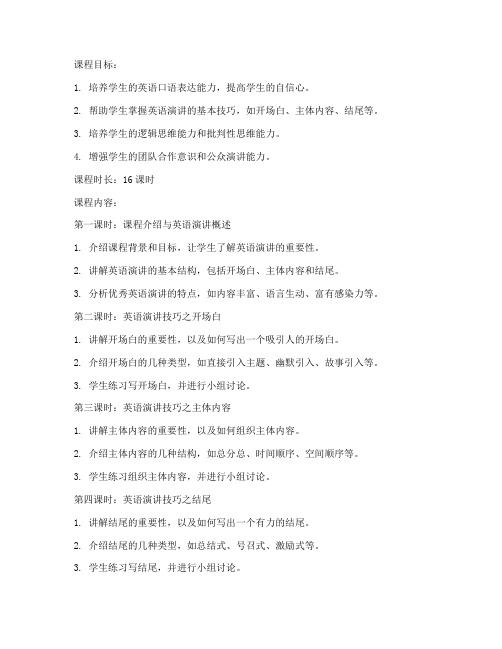
课程目标:1. 培养学生的英语口语表达能力,提高学生的自信心。
2. 帮助学生掌握英语演讲的基本技巧,如开场白、主体内容、结尾等。
3. 培养学生的逻辑思维能力和批判性思维能力。
4. 增强学生的团队合作意识和公众演讲能力。
课程时长:16课时课程内容:第一课时:课程介绍与英语演讲概述1. 介绍课程背景和目标,让学生了解英语演讲的重要性。
2. 讲解英语演讲的基本结构,包括开场白、主体内容和结尾。
3. 分析优秀英语演讲的特点,如内容丰富、语言生动、富有感染力等。
第二课时:英语演讲技巧之开场白1. 讲解开场白的重要性,以及如何写出一个吸引人的开场白。
2. 介绍开场白的几种类型,如直接引入主题、幽默引入、故事引入等。
3. 学生练习写开场白,并进行小组讨论。
第三课时:英语演讲技巧之主体内容1. 讲解主体内容的重要性,以及如何组织主体内容。
2. 介绍主体内容的几种结构,如总分总、时间顺序、空间顺序等。
3. 学生练习组织主体内容,并进行小组讨论。
第四课时:英语演讲技巧之结尾1. 讲解结尾的重要性,以及如何写出一个有力的结尾。
2. 介绍结尾的几种类型,如总结式、号召式、激励式等。
3. 学生练习写结尾,并进行小组讨论。
第五课时:英语演讲技巧之语言表达1. 讲解语言表达的重要性,以及如何运用丰富的词汇和句型。
2. 介绍演讲中的修辞手法,如比喻、拟人、排比等。
3. 学生练习运用修辞手法,并进行小组讨论。
第六课时:英语演讲技巧之语调与节奏1. 讲解语调与节奏在演讲中的重要性,以及如何调整语调与节奏。
2. 学生练习调整语调与节奏,并进行小组讨论。
第七课时:英语演讲技巧之肢体语言1. 讲解肢体语言在演讲中的重要性,以及如何运用肢体语言。
2. 学生练习运用肢体语言,并进行小组讨论。
第八课时:英语演讲实战演练1. 学生分组进行英语演讲实战演练,互相点评和指导。
2. 教师针对学生的演讲进行点评和指导。
第九课时:英语演讲比赛与答辩技巧1. 讲解英语演讲比赛与答辩的基本规则和技巧。
十六届英语说课稿范文模板

十六届英语说课稿范文模板
尊敬的评委老师,各位同事,大家好。
今天,我有幸在这里与大家分
享我的英语说课稿。
我将从教学目标、教学内容、教学方法、教学过程、板书设计以及教学反思六个方面进行阐述。
首先,我们来谈谈教学目标。
本节课的教学目标是让学生能够熟练掌
握并运用本课的词汇和句型,提高学生的英语听说能力,同时激发学
生的英语学习兴趣。
接下来是教学内容。
本节课我们将学习关于“家庭生活”的词汇和句型,例如家庭成员的称呼、日常活动的表达等。
在教学方法上,我将采用情景教学法、任务型教学法和合作学习法。
通过创设真实的语言环境,让学生在实际情境中学习和使用英语。
教学过程分为以下几个步骤:
1. 导入:通过展示家庭成员的图片,引导学生进入学习主题。
2. 新课呈现:教授新词汇和句型,并通过多媒体教学辅助学生理解。
3. 操练:通过小组合作、角色扮演等形式,让学生在实际对话中操练
所学内容。
4. 应用:设计一些与生活相关的任务,让学生运用所学知识解决问题。
5. 总结:回顾本节课的重点内容,鼓励学生进行自我总结。
在板书设计上,我将使用清晰的结构和色彩,突出重点词汇和句型,
便于学生记忆。
最后,是教学反思。
课后,我将根据学生的反馈和课堂表现,对教学
方法和内容进行调整,以满足不同学生的学习需求。
通过本节课的学习,我相信学生们不仅能够掌握相关的英语知识,更能在实际生活中灵活运用,从而提高他们的英语综合运用能力。
谢谢大家的聆听,期待与大家共同探讨和进步。
16分钟英语说课稿范文

16分钟英语说课稿范文尊敬的评委老师,各位同仁,大家好。
今天,我将向大家展示一节16分钟的英语说课稿。
本节课的主题是“环境保护”,旨在通过本节课的学习,让学生了解环境保护的重要性,并能够运用英语表达自己的观点和看法。
课程目标:1. 学生能够理解并掌握与环境保护相关的基本词汇和表达方式。
2. 学生能够通过听说读写等活动,提高英语语言技能。
3. 学生能够认识到环境保护的重要性,并能够用英语进行简单的讨论。
教学重点:- 环境保护相关的词汇和短语。
- 英语口语表达能力的提升。
教学难点:- 学生能够流利地使用英语表达对环境保护的看法。
教学方法:- 任务型教学法:通过完成具体的任务来学习语言。
- 合作学习:鼓励学生小组合作,共同探讨问题。
教学过程:1. 导入(2分钟)- 通过展示一些环境污染的图片,引起学生对环境保护的关注。
2. 词汇学习(3分钟)- 教授与环境保护相关的词汇,如:recycle, conserve, pollution, sustainable等。
3. 听力练习(3分钟)- 播放一段关于环境保护的英语听力材料,让学生获取信息。
4. 口语练习(3分钟)- 分组进行角色扮演,模拟环保志愿者向社区居民宣传环保知识。
5. 阅读材料(2分钟)- 提供一篇关于环境保护的英文文章,让学生快速阅读并找出关键信息。
6. 写作练习(2分钟)- 让学生写一篇简短的环保倡议书,提出自己对环境保护的建议。
7. 总结讨论(1分钟)- 邀请学生分享他们的观点和想法,并对本节课内容进行总结。
8. 作业布置(1分钟)- 布置相关的英语写作任务,如写一篇关于如何在生活中实践环保的短文。
教学反思:- 在课后,我会反思本节课的教学效果,考虑如何改进教学方法,以更好地激发学生的学习兴趣和参与度。
通过本节课的学习,学生不仅能够学习到与环境保护相关的英语知识,还能够提高自己的英语口语表达能力,同时增强环保意识。
谢谢大家。
英语六年级说课稿Lesson16

英语六年级说课稿Lesson16英语六年级说课稿Lesson16文章摘要:本文章的主要内容是英语六年级说课稿Lesson16,欢迎您来阅读并提出宝贵意见!英语六年级说课稿Lesson16一、说教材我说课的内容是小学三年级下册第三单元第十六课,本课是功能型的交际型的交际训练课,我借助任务型教学采用多样化的教学手段将听、说、玩、演、唱溶于一体,激发学生学习英语的兴趣和愿望,使学生通过合作学习体验荣誉感和成就感从而树立自信心,发展自主学习的能力,形成初步用英语进行简单日常交际的能力。
结合新课程标准和大纲提出的基础教育阶段英语课程的总体目标和具体要求我将本课教学目标设计如下:语言知识目标:1、使学生掌握介绍他人的句型:①Whoˊsthis?②Thisis2、学习认读单词:grandfather,grandmother语言技能目标:①、使学生能够根据指令做动作。
②、根据图片和情境说出单词和句子。
③、在图文或场景下进行简单的英语交流和表演。
情感态度目标:通过本课学习使学生有兴趣听、说英语、背歌谣,做游戏、敢干开口,乐于模仿,在鼓励性评价中树立信心在小组活动中积极参与合作,从而意识到交流对于学习英语的重要意义。
充分利用教材和教师的多媒体教学所提供的学习资源,实现自由参与和创新,能主动与他人交流,并克服交流中的困难,使交际顺利进行。
文化意识目标:能够恰当使用英语中家庭成员之间的称呼,问候语,了解英语国家中介绍他人的方式并对学生进行亲情教育。
结合教学目标的要求,我把本课的重难点设置为1、介绍他人的句型Thisis2、对情境进行模仿,创新。
我主要通过感知新教材设置灵活运用这三个主要步骤来突破教材重难点的。
在教学开始让学生以旧带新引入新知,通过对教材的了解感知新任务,并在教师用红灯,头饰、图片、录音等多种媒介的感官刺激下实现对知识的体验和实践最后在真实的生活情境中运用、实现能力的发展。
说教法和学法:(一)小组活动学习法把全班分成6个小组事先用表示家庭成员名称的单词命名,课堂各项教学活动匀以小组活动为主线,结对或全班活动为辅,学生互相交流,切磋,共同完成学习任务,在合作中感受学习英语的乐趣及交流的意义,也通过小组成员之间荣辱与共的关系而形成同步学习的环境。
说课稿Unit 3 Lesson 16
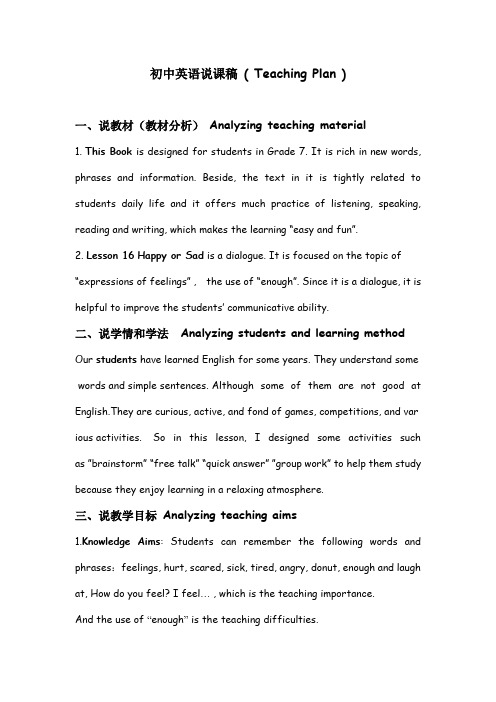
初中英语说课稿( Teaching Plan )一、说教材(教材分析) Analyzing teaching material1. This Book is designed for students in Grade 7. It is rich in new words, phrases and information. Beside, the text in it is tightly related to students daily life and it offers much practice of listening, speaking, reading and writing, which makes the learning “easy and fun”.2. Lesson 16Happy or Sad is a dialogue. It is focused on the topic of “expressions of feelings” , the use of “enough”. Since it i s a dialogue, it is helpful to improve the students’ communicative ability.二、说学情和学法 Analyzing students and learning method Our students have learned English for some years. They understand some words and simple sentences. Although some of them are not good at English.They are curious, active, and fond of games, competitions, and var ious activities. So in this lesson, I designed some activities such as ”brainstorm”“free talk” “quick answer””group work” to help them study because they enjoy learning in a relaxing atmosphere.三、说教学目标 Analyzing teaching aims1.Knowledge Aims: Students can remember the following words and phrases:feelings, hurt, scared, sick, tired, angry, donut, enough and laugh at, How do you feel? I feel… , which is the teaching importance.And the use of “enough” is the teaching difficulties.2.Ability aims: In this lesson, Students can use the expressions “ How do you feel ? I feel…” in the dialogue to talk about their feelings in their daily life freely. Besides, they should also practice their listening, reading, speaking and writing skills through different tasks.3. Moral Aims : Students can have a better understanding of importance of their feelings and learn how to work together in groups.四、说教法 Analyzing teaching methodsIn this lesson, I will use audio-visual methods, 5 steps and Task-based teaching methods. That is Lead-in, presentation, listening, reading and practice. And every step has its tasks.五、说教学过程 Analyzing the teaching proceduresStep 1 Lead-in (导入)I will use a song(歌曲导入) to make them interested in the topic of this lesson, and I will give them a question(设问)“What is the song about?”They will think of “feelings”. Then they will tell me “high=happy”and “down= sad” . After that, I will show them the mind map(思维导图)to ask them to brainstorm other words about feelings, such as: sad, tired, sick, and so on. At last, we will have a free talk(自由对话)by : How do you feel ?I feel…Step 2 Presentation (呈现)In this step, we will come to the new words, I will introduce the new words by pictures and sentences.They should read the words by themselvesaccording to the pronunciation(音标自自主拼读). And guess the meanings through pictures and sentences. Such as, laugh at … Among them, the use of enough is teaching difficulty(教学难点). So I will give them more pictures and examples to make more sentences .At last, I will give them a minute to review and understand these knowledge we have learned, which will make the following steps easier.Step 3 Listening (听力)I designed 4 questions in forms of choice. Before listening, they will read the questions with me and circle the key words. (听前审题,划关键词) After listening to the questions for twice, they will check their answers. At last, I will ask students to practice the phrase “want sb to do” with more examples.Step 4 Task-based reading (任务型阅读)In this part, there are 3 different tasks, (3种题型) and each has a language point, such as: What’s wrong? = What’s the matter?“Don’t be Sad.”“One donut a day is enough.” Besides, students should find those language points by themselves by reading and discussion. Then can think more examples : One apple a day; two oranges a day; and so on. All the tasks are helpful to increase their ability of reading and discovery.After finishing the tasks before, We will have a summary in forms of “Quick Answer” to consolidate the knowledge we have learned. They will be active to answer them.Step 5 Practice1.Then, with those language points, we will do some exercise on the paperto learn better.2.There is a writing practice . Before they start to write, I will givesome questions to discuss in groups. They can prepare for the writing (小组讨论问题为写作做铺垫). If time is enough, a student will be asked to show his writing on the blackboard. If we can’t finish this part, I will ask them to finish the writing as homework.3.Homework(1).Finish the writing(2).Finish the exercise book(3). Classified homework (分层作业)*Read and remember the words of Lesson 13-16 for write on the paper.(For students who can’t recite the text)*Students who have recited the text needn’t do the last homework. 4. Blackboard designThat’s all! Thank you for listening!。
- 1、下载文档前请自行甄别文档内容的完整性,平台不提供额外的编辑、内容补充、找答案等附加服务。
- 2、"仅部分预览"的文档,不可在线预览部分如存在完整性等问题,可反馈申请退款(可完整预览的文档不适用该条件!)。
- 3、如文档侵犯您的权益,请联系客服反馈,我们会尽快为您处理(人工客服工作时间:9:00-18:30)。
Lesson 16 Speech MakingTeaching Aim and RequirementAimed at ensuring the Ss to have a basic knowledge of public speaking.Teaching methodsPPt, interact between teacher & studentAssignmentsWhat are the essentials of an effective speech?How to overcome nervousness?Teaching proceduresIntroductionWhat is public speaking?•Public speaking, as its name implies, is a way of making your ideas public – of sharing them with other people and of influencing other people.A Brief Introduction to public speakingI. How to Prepare a Speech•Stating Your Objectives:◇inform◇train◇persuade◇sell•Analyzing Your AudienceWhat to learn about the audience?Their opinions and levels of prior knowledge of your subject ; their likely bias, both personal and professionalhow do you learn it?Ask the person who has invited you to speak. Find out what the occasion is and if there is a program theme.•Choosing a Speech Topic and the Speech ThemeSix Criteria1. The topic should be interesting to you.2. It should be interesting to your audience or at least be capable of beingmade interesting to them.3. It should be appropriate to the situation.4. It should be appropriate to the time available.5. It should be manageable.6. It should be worthwhile. Don't waste your audience’s time.•Gathering and Selecting Appropriate Materialsconvincing materialsseven major types of materials: descriptions and explanations, statistics, examples, testimony, comparison and contrast, repetition and restatement, and visuals. guidelines•Outlining Your Speechguidelines:1. Write and label your specific purpose at the top of your outline.2. Indicate main ideas, points, sub-points, and supporting materialsproperly.3. Use at least two subdivisions, if any, for each point.Using subdivisions helps you give attention to all the points you want to say.4. Label the introduction, main body and conclusion.II. How to Write a Great Speech•Organizing the Body of the SpeechA.The IntroductionA. It should introduce the topic. providing background information, definitionsexplanations, etc.B. Generally it should contain the thesis statement.C. It should be interesting enough to make the listener want to continue listening.Anecdotes, shocking statistics, quotes, and rhetorical questionsD. It should indicate how your topic will be developed.E. tell your listeners WHY they should listen to you; such as how they will benefit.F. include the method of organization that you will follow. This helps the listenerprepare for what you are going to say and help them organize the information.An effective introduction•Creates a favorable first impression with the audience•Boosts a speaker’s self-confidenceGaining attention•relate the topic to the audience•State the importance of the topic•Startle the audience•Arouse the curiosity of the audience•Question the audience•Begin with quotation•Tell a story•Using visual aids•…Reveal the topic•Clearly states the speech topic•Establish the credibility and goodwill of the speakerPreview the body•Tells audience what to listen for in the rest•Provide a smooth lead-in•Present special informationB.Main Bodya. Each main point discusses one aspect of the thesis.b. The main points should be linked with clear transitions so as to give thebody coherence and unity.C. ConclusionA conclusion can restate the thesis.A conclusion can restate the main points.A conclusion can call for some sort of action (particularly in a persuasive piece)A conclusion can highlight areas for further research.A conclusion can suggest results or consequences.A conclusion can remind the audience of the importance of the informationpresented.The speaker can thank the audience for their attention.A conclusion should NEVER bring up a new topic.A speaker should NEVER apologize for their information. The last thing you wantto happen is for the audience to question your credibility.2 functions of conclusion•Signal the end of the speech•Reinforce the audience’s understanding of the speech•Using Speech LanguageA. Using Language AccuratelyB. Use Language ClearlyC. Use language VividlyIII. How to Deliver a Great Speech•Physical Delivery1. postureA public speaker should look comfortable, confident and prepared to speak. Inposture, the two extremes to avoid are rigidity and sloppiness.2. facial expressionsYour facial expression must match what you are saying.3. movementa. Never turn your back on the audience while you are speaking.b. If you move about on the stage, make your movements purposeful.c. Be aware of all potential obstacles on the stage.4. gestures5. Eye contactLet your gaze move over each member of the audiencedon’t choose one person and look fixedly at him or her.avoid the temptation to look over the heads of your audience or to hold your notes in front of your face.6. AppearanceThe way you dress and present yourselfDress appropriately to the audience•Vocal DeliveryV ocal delivery refers to the use of your voice to convey your message.1. rateRate is the speednot too slowly or too quickly. Varying your rate can be critical.2. pausetemporary stopspause before and after a major point. You can use pauses to illustrate that you are changing from one point to another. You can use pauses for emphasis3. volumeV olume refers to how loud one speaksSpeak too soft Speak too loudchanging the volume at certain points emphasize important ideas.Raising your voice lowering your voice4. pitchPitch refers to the high or low quality of your voice.V olume is measured in terms of loudness.The pitch of your voice in public speaking refers to the “excitement” or “enthusiasm” level in your voice.pitch can be raised and lowered for emphasis.vary your pitch.5. Pronunciation6. articulation : not slur, speak clearlyIV. How to Analyze and Evaluate Speech•three “M”s: matter, manner and method.Speaking to PersuadeI. Persuasion: a Psychological process• A. Persuasion is the most complex and the most challenging.•(controversial topics, involving values and beliefs; listeners’ own ideas)• B. Listeners: mental give-and-take•(listeners: assessment on speakers)II. The Target Audience•The part of the whole audience a speaker most wants to reach with his message. Agree and disagree audience•Adapt the speech to the values and concerns of the TA•Do not exclude other listenersIII. Monroe’s Motivated Sequence•Monroe's motivated sequence is a technique for organizing persuasive speeches that inspire people to take action.•Alan H. Monroe (Purdue University) 1930s•what creates makes a motivational speech actually motivating.• a 5-step method for organizing motivational speeches.1.AttentionGet the attention of your audience using a detailed story, shocking example, dramatic statistic, quotations, etc.E.g. Hey! Listen to me, I have a PROBLEM!2.NeedShow that the problem about which you are speaking exists, that it is significant, and that it won't go away by itself. Use statistics, examples, etc.Convince your audience that there is a need for action to be taken.E.g. Let me EXPLAIN the problem.3.Satisfy.You present your plan and show how it will work. Be sure to offer enough details about the plan.E.g. But, I have a SOLUTION!4.VisualizationTell the audience what will happen if the solution is implemented or does not take place. Be visual and detailed.E.g. If we IMPLEMENT my solution, this is what will happen.5.Action.Tell the audience what action they can take personally to solve the problem.Say exactly what you want the audience to do and how to do it.E.g. You can help me in this specific way. Are YOU willing to help me?Advantage of MMS•It emphasizes what the audience can do. Monroe's motivated sequence emphasizes the action the audience can take.•Sample Speech:The Ultimate GiftIV. Persuasive Speeches on Questions of Fact• A. seek to persuade audience to accept the speaker’s view of the facts on a particular issue.E.g. Will the economy be better or worse next year?• B. different from an informative speechIS: give information as impartially as possible ≠ argue for a point of viewPS: persuade the audience to accept the speaker’s view about the informatione.g. In a trial lawyer jury guilt / innocent defendantV. Persuasive Speeches on Questions of Value• A. Judgments based on a person’s beliefs about what’s right or wrong• B. 2 steps:1. define the standards for value judgments2. judge the subject of the speech against the standards.VI. Persuasive Speeches on Questions of Policy• A. deal with specific courses of action: involve questions of fact and value; go beyond that• B. 2 types:1. gain passive agreement that a policy is desirable, necessary & practical2. motivate the audience to take immediate action• C. 3 basic issues – need, plan & practicality1. need: (no) need for a change2. a specific plan: solve the need3. practicality: Plan: workable, solve the need without creating newproblemsVII. Methods of PersuasionA.Building credibility– 1. Credibility affected by: competence & charactercompetence: speaker’s intelligence, expertise & knowledge of the subjectcharacter: speaker’s sincerity, trustworthiness– 2. 3 types of credibility: initial credibility; derived credibility;terminal ~– 3. 3 strategies to ↑credibility:a. explaining their competenceb. establishing common ground with the audiencec. delivering speeches fluently, expressively and with convictioning Evidence– 1. examples, statistics, testimony– 2. 4 tips to use evidence effectively: use specific evidence; novel ~; use ~ from credible sources; make clear the point of the ~C.Reasoning–Reasoning: the process of drawing a conclusion based on evidence–use reasoning from specific instances–use reasoning from principle–use analogical reasoning, ×casual reasoningD.Emotions Appeals– 1. Emotions Appeals (motivational appeals): make listeners feel sad, happy, angry, fearful, etc.– 2. 3 ways: with emotionally charged language; with vivid examples;speak with sincerity and conviction。
